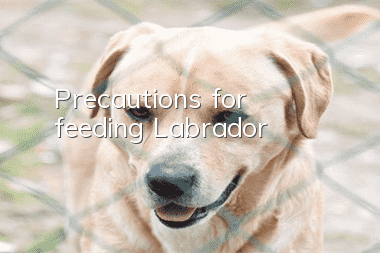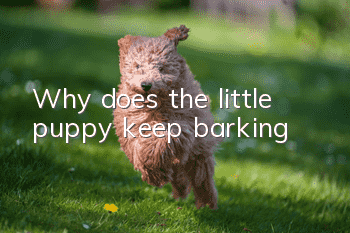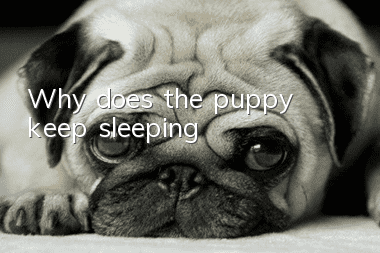Precautions for feeding Labrador

① Feed Labrador (Labrador retriever is referred to as Lala, the same below) at a regular, quantitative and fixed location. Timing can develop the dog's timing conditioned reflex, secrete gastric juice, increase appetite, and promote digestion and absorption. Generally, adult dogs are fed twice a day, once in the morning and once in the evening, and slightly more at night. Lala under 1 year old should be fed 3 times a day; Lala under 3 months old should be fed 4 times a day; puppies under 2 months old should be fed 5 times a day. The variety of dog food can be renovated, but the quantity should be relatively stable. The feeding location can be inside or outside the kennel, but dogs are generally fed in the kennel. The purpose of a fixed location is to keep the environment relatively stable and easy to manage. Some dogs will refuse to eat and lose appetite when changing feeding places.
②Except for summer, Lala should be fed warm feed. The temperature of the feed is preferably around 40°C, and should not be too cold or too hot; cold food can be fed in summer, and the feed must be heated in winter. It is best to keep the temperature around 35°C, which is not hot to the touch. Feed that is too hot will not only affect the appetite, but also burn the dog’s teeth; feed that is too cold will easily cause stomach upset.
③Each Lara tableware should be fixed and should not be used indiscriminately. When feeding multiple dogs, be especially careful not to exchange the food bowls of each dog to prevent the spread of disease. Wash after feeding and boil and disinfect regularly. A dog’s life is very regular, so it’s best to let Lala have her meal in its proper place.
④ Pay attention to Lala’s eating situation when feeding. If there is leftover food or no food, find out the cause and take timely measures. The leftover feed should be taken away immediately and should not be left for a long time for the dog to eat at any time.
⑤ Pay special attention to puppies and sick dogs. It is best to feed puppies 4 times a day. The food should be added from less to more, from worse to better. The fixed food amount should be added less and less, and it is not advisable to feed it very full. Sick dogs should be fed more liquid food, lean meat and eggs or non-irritating, easily digestible, nutritious sick food. Sick dogs should drink more cold boiled water. If the water is not enough, add it in time.
⑥Do not let Lala do strenuous exercise before and after feeding.
⑦Food suitable for puppies
(1) Food specifically for puppies: such as dog food and canned food.
(2) Calcium: Supplement calcium products with high natural content, such as super calcium, to promote bone and tooth development of puppies.
(3) Milk powder for puppies: There is special goat milk powder for puppies.
(4) Egg yolk: The advantage of egg yolk is that it is not only rich in protein, but also contains vitamin A, calcium and minerals that are easy to digest and absorb.
(5) Vitamins and minerals: For puppies with poor physical fitness, consider supplementing some additional vitamins and minerals, and consider feeding21 Golden Vita, and also Puppy Golden Vita for pets.
(6) Meat: Although beef, pigs, chicken, etc. are excellent foods, when feeding puppies, you should choose fat-free parts because fat easily deteriorates, and feed cooked meat rather than raw meat. , do not feed any meat with bones.
⑧Foods that dogs cannot eat
(1) Do not eat bones, especially sharp bones such as chickens and ducks, which will nick the intestines and stomach.
(2) Do not eat liver for a long time. Long-term consumption may cause excessive vitamin A or even poisoning.
(3) Foods such as onions (including onions) and garlic cannot be eaten. Ingestion of such foods by some dogs can cause hemolysis of cells and blood in urine.
(4) Don’t eat chocolate. Real chocolate contains a variety of methylxanthine derivatives, including caffeine and theobromine. Taking small doses of methylxanthines can cause vomiting and diarrhea in dogs. Chocolate contains a large amount of theobromine and a small amount of caffeine. After taking theobromine and caffeine, the dog's heart rate will suddenly increase to more than twice the normal rate, and some dogs will run around wildly. If your dog eats too much chocolate, it can cause muscle spasms and even shock. The more and more authentic chocolate a dog eats, the more harm it will suffer.
(5) Do not eat seafood and other allergenic foods.
(6) Do not eat foods high in sugar, fat and salt. High-sugar and high-fat foods can easily make dogs gain weight and induce a series of diseases; excessive salt will inevitably increase the burden of kidney excretion, affect kidney health, disrupt body fluid balance, and cause various skin diseases.
(7) Raw eggs cannot be eaten, but cooked eggs are very suitable for dogs. Raw egg whites contain a protein called Avidin, which depletes the dog's body of vitamin H (found in the B vitamins), which is an indispensable nutrient for dog growth and healthy fur. In addition, raw eggs are usually also Contains germs such as salmonella.
(8) Do not eat raw meat and try not to feed poultry. The dog’s immune system cannot adapt to artificially raised poultry and meat. The most common types of bacteria, Salmonella and Bacillus, are very dangerous to dogs. Poultry, especially pork, has larger fat globules than other meats, which may clog your dog's capillaries, especially bacon containing sodium nitrate.
(9) Do not drink milk (you can feed a small amount of yogurt, too much will cause diarrhea). Many dogs have lactose discomfort. If your dog develops gas, diarrhea, dehydration or skin inflammation after drinking milk, you should stop Feed milk. Dogs with lactose intolerance should consume lactose-free milk.
(10) It is not recommended to eat mushroom food. Commercially available edible mushrooms, mushrooms, etc. are not easy to digest. Dogs should avoid eating them to avoid diarrhea or vomiting.
(11) Don’t eat grapes. Grapes can cause nephrotoxicity (kidney failure).), should never be fed to dogs.
(12) Pungent spices such as ginger, curry powder, and chili are too irritating to the stomach and should not be fed.
In addition, no matter what you eat, do not let your dog overeat to avoid acute diseases such as gastric dilation. Overeating is more harmful to puppies. Since puppies have weak digestion and poor ability to control hunger, they are more likely to become oversaturated, which can lead to acute gastrointestinal symptoms such as diarrhea and vomiting, which can even be life-threatening. .
Daily exercise
From birth to 1 month old, there is no need to artificially control the amount of exercise of the dog, just let it move at will.
1-2 months old, you can play with the dog appropriately, within 5 minutes each time.
3-4 months old, you can exercise appropriately, no more than 20 minutes at a time.
4-6 months, when all immunizations are completed, you can take it out for a walk, but it is not recommended to run wildly (in summer, it is recommended to take it out for a walk and defecation in the morning).
6-9 months. Puppies in this period should avoid forced training exercises such as throwing balls. The most is to allow the dogs to exercise freely but not violently on open grass.
From 9 to 12 months old, you can start swimming and perform short-distance throwing and catching training.
12-18 months old, it is already a young dog: it can easily ride a bicycle or play catch and run on the grass.
A dog is considered an adult when it is over 18 months old and can perform a considerable amount of exercise to increase muscle lines and muscle strength.
Under normal circumstances, taking a dog out for a walk for 30-90 minutes every day can meet the dog's exercise needs. Of course, when the dog is about 3 months old, it should be properly trained and guided to develop in the right direction.
- What do ancient shepherd dogs eat?
- What is nutritious food for dogs?
- How to raise golden retriever puppies to grow fast
- How to tell the difference between Pekingese dogs
- What is the standard body shape of a Husky?
- How to train a puppy to shake hands
- How to remove ticks from dogs
- What should I do if my Pomeranian loves to bite?
- Why does the little puppy keep shaking?
- What is the personality of the Afghan dog?



